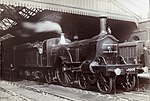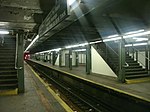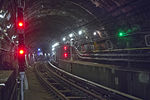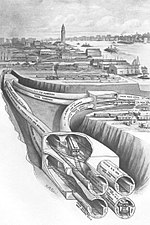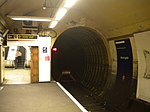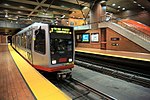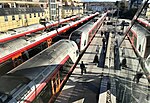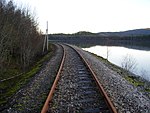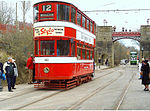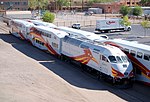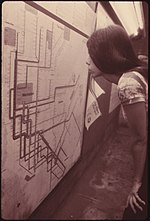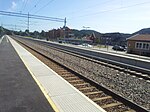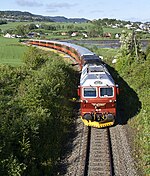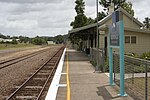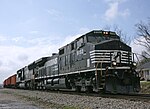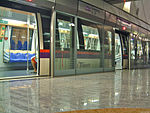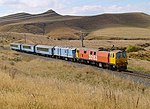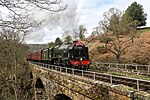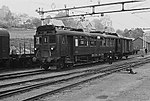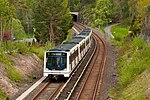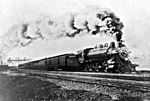This is an archive of article summaries that have appeared in the Selected article section of Portal:Trains in 2020. For past archives, see the complete archive page.
- Week 1
The Great Northern Railway (GNR) was a British railway company incorporated in 1846 with the object of building a line from London to York. It quickly saw that seizing control of territory was key to development, and it acquired, or took leases of, many local railways. It succeeded in reaching into the coalfields of Nottinghamshire, Derbyshire and Yorkshire, as well as establishing dominance in Lincolnshire and North London. Bringing coal south to London was dominant, but general agricultural business and short and long distance passenger traffic were important activities. Its fast passenger express trains captured the public imagination, and its Chief Mechanical Engineer Nigel Gresley became a celebrity. Anglo-Scottish travel on the East Coast Main Line became commercially important; the GNR controlled the line from London to Doncaster and allied itself with the North Eastern Railway and the North British Railway so as to offer seamless travel facilities. In the grouping following the Railways Act 1921, the Great Northern Railway became a constituent of the London and North Eastern Railway, which took control at the beginning of 1923. Although many local lines have been closed, much of the network is still active.
Recently selected: CTA Holiday Train - Devon and Somerset Railway - Deutsche Reichsbahn (East Germany)
- Week 2
Grand Central Terminal is a major commuter rail terminal in Midtown Manhattan, New York City, serving the Metro-North Railroad's Harlem, Hudson and New Haven Lines. The station's history dates to the mid-19th century. The magnate "Commodore" Cornelius Vanderbilt bought the Hudson River and New York Central Railroads in 1867, and created Grand Central Depot for the Hudson River, New York Central, and New Haven railroads in 1871. Due to rapid growth, the depot was reconstructed and renamed Grand Central Station by 1900. The current structure was opened on February 2, 1913. The terminal continued to grow until the 1940s, when train traffic started to decline. In the 1950s and 1970s, there were two separate proposals to demolish Grand Central, though both were unsuccessful. The terminal was given several official landmark designations during this period. Minor improvements occurred through the 1970s and 1980s, followed by an extensive rehabilitation in the mid- and late 1990s. In 1991, Amtrak consolidated its New York City services at nearby Penn Station. The East Side Access project, which will bring Long Island Rail Road service to a new station beneath the terminal, is expected to be completed in late 2022.
Recently selected: Great Northern Railway (Great Britain) - CTA Holiday Train - Devon and Somerset Railway
- Week 3
Hunts Point Avenue is an express station on the IRT Pelham Line of the New York City Subway, served by the 6 train at all times and the <6> train on weekdays in the peak direction. It is located at Hunts Point Avenue and Southern Boulevard in the Foxhurst neighborhood in the Bronx. This station opened in 1919 as part of the Interborough Rapid Transit Company (IRT)'s Pelham Line. The line was constructed as part of an agreement between New York City and two private transit operators to expand transit service across the city known as the Dual Contracts. Express service at the station began in 1946, and the station was renovated to become compliant with the Americans with Disabilities Act of 1990 in 2014.
Recently selected: history of Grand Central Terminal - Great Northern Railway (Great Britain) - CTA Holiday Train
- Week 4
The International (formerly International Limited) was a named passenger train operated between Chicago and Toronto. It was originally an overnight train operated by the Grand Trunk Railway of Canada and its successors the Canadian National Railway and Grand Trunk Western Railroad, running as far as Montreal. The train was cut back to Port Huron, Michigan, in 1970 and discontinued in 1971. In 1982, Amtrak and Via Rail revived the route by extending Amtrak's Blue Water Limited from Port Huron to Toronto. It was renamed as the International the next year. The service was initially successful but encountered numerous funding crises in the late 1990s and early 2000s. Substantial delays crossing the international border after the September 11th attacks, combined with freight congestion and the 2003 SARS outbreak, drastically reduced ridership. In 2004, the train was replaced with the Blue Water, which offered a better interstate schedule and higher reliability.
Recently selected: Hunts Point Avenue station - history of Grand Central Terminal - Great Northern Railway (Great Britain)
- Week 5
King's Cross St. Pancras (formerly King's Cross) is a London Underground station on Euston Road in the Borough of Camden, Central London. It serves King's Cross and St Pancras main line stations in fare zone 1, and is an interchange between six Underground lines. The station, one of the first to open on the network, opened in 1863 along with the Metropolitan line, subsequently catering for the Hammersmith & City and Circle lines. It was expanded in 1868 with the opening of the City Widened Lines, and the Northern and Piccadilly platforms opened in the early 20th century. During the 1930s and 1940s, the station was restructured and partially rebuilt to cater for expanded traffic. The Victoria line connection opened in 1968. The 1987 King's Cross fire that killed 31 people is the deadliest accident to occur on the Underground and resulted in widespread safety improvements and changes throughout the network. The station was extensively rebuilt in the early 21st century to cater for Eurostar services that moved from Waterloo to St Pancras, reopening in 2009.
Recently selected: International (Amtrak train) - Hunts Point Avenue station - history of Grand Central Terminal
- Week 6
The New York City Subway signaling system currently uses Automatic Block Signaling, with fixed wayside signals and automatic train stops. Many portions of the signaling system were installed between the 1930s and 1960s and most trains on the system are manually operated. Because of the age of the subway system, many replacement parts are unavailable from signaling suppliers and must be custom built for the New York City Transit Authority, which operates the subway. There are two different schemes of signaling in the system. The most used scheme is used on all B Division lines, originally built to the Brooklyn–Manhattan Transit Corporation (BMT) and Independent Subway System (IND)'s wider specifications, and on most of the A Division lines, built to the narrower specifications of the Interborough Rapid Transit Company (IRT). As part of the modernization of the New York City Subway, the MTA plans to upgrade much of the system with communications-based train control (CBTC) technology, which will control the speed, and starting and stopping, of subway trains. The CBTC system is mostly automated and uses a moving block system—which reduces headways between trains, increases train frequencies and capacities, and relays the trains' positions to a control room—rather than a fixed block system. The implementation of CBTC requires new rolling stock to be built for the subway routes using the technology, as only newer trains use CBTC.
Recently selected: King's Cross St Pancras tube station - International (Amtrak train) - Hunts Point Avenue station
- Week 7
The Turtle Creek Industrial Railroad (reporting mark TCKR) was a short line freight railroad that operated in western Pennsylvania between the boroughs of Export and Trafford, where it connected to the Pittsburgh Line. The TCKR was a wholly owned subsidiary of the Dura-Bond Corporation, a steel products company headquartered in Export. The company purchased the railroad from Conrail (the successor to the Pennsylvania Railroad) in 1982. For the next 27 years, three to five trains per week made the round trip along just over ten miles (16 km) of track, delivering materials such as steel pipe to the shortline's parent company in Export and lumber to lumber yards in neighboring Murrysville. In the shortline's heyday, trains of typically about four cars in length were hauled by one of the railroad's two 1940s era switch engines, operated by a two-man crew. The railroad was in service until 2009, when flash flooding of Turtle Creek severely damaged the TCKR's tracks which ran adjacent to the stream. After cessation of service, most of the right-of-way was sold to Westmoreland County to become part of the Westmoreland Heritage Trail.
Recently selected: signaling of the New York City Subway - King's Cross St Pancras tube station - International (Amtrak train)
- Week 8
The Uptown Hudson Tubes are a pair of tunnels that carry PATH trains between Manhattan, New York City, to the east and Jersey City, New Jersey, to the west, crossing under the Hudson River. Despite their name, the tubes do not enter Uptown Manhattan, but are so named because they are located to the north of the Downtown Hudson Tubes, which connect Jersey City and the World Trade Center. Dewitt Clinton Haskin first attempted to construct the Uptown Hudson Tubes in 1873. The project was canceled in 1883 due to a lack of money. A British company attempted to complete the tunnels in 1888, but also ran out of money by 1892, by which point the tunnels were nearly half-finished. In 1901, a company formed by William Gibbs McAdoo resumed work on the tubes, and by 1907, the tunnels were fully bored. The Uptown Hudson Tubes opened to passenger service in 1908 as part of the Hudson & Manhattan Railroad and were completed by 1910. The Uptown Hudson Tubes contained seven original stations. PATH operates two services through the Uptown Tubes on weekdays: Hoboken–33rd Street and Journal Square–33rd Street. On late nights, weekends, and holidays, they are combined into the Journal Square–33rd Street (via Hoboken) service.
Recently selected: Turtle Creek Industrial Railroad - signaling of the New York City Subway - King's Cross St Pancras tube station
- Week 9
The Moorgate tube crash occurred on 28 February 1975 at 8:46 am on the London Underground's Northern City Line; 43 people died and 74 were injured after a train failed to stop at the line's southern terminus, Moorgate station, and crashed into its end wall. It is considered the worst peacetime accident on the London Underground. No fault was found with the train, and the inquiry by the Department of the Environment concluded that the accident was caused by the actions of Leslie Newson, the 56-year-old driver. The post-mortem on Newson showed no medical reason to explain the crash. A cause has never been established, and theories include suicide, that he may have been distracted, or that he was affected by conditions such as transient global amnesia or akinesis with mutism. In the aftermath of the crash, London Underground introduced a safety system that automatically stops a train when travelling too fast. This became known informally as Moorgate protection. Northern City Line services into Moorgate ended in October 1975 and British Rail services started in August 1976. After a long campaign by relatives of the dead, two memorials were unveiled in the vicinity of the station, one in July 2013 and one in February 2014.
Recently selected: Uptown Hudson Tubes - Turtle Creek Industrial Railroad - signaling of the New York City Subway
- Week 10
The Morayshire Railway was the first railway to be built north of Aberdeen, Scotland. It received royal assent in 1846 but construction was delayed until 1851 because of the adverse economic conditions existing in the United Kingdom. The railway was built in two phases with the section from Elgin to Lossiemouth completed in 1852. When the Inverness and Aberdeen Junction Railway (I&AJR) reached Keith via Elgin, the Morayshire was able to complete the Speyside second phase by connecting the Craigellachie line at Orton. Initially, the Morayshire ran its own locomotives on the I&AJR track between Elgin and Orton but this was short-lived and the Morayshire carriages were then hauled to Orton by the I&AJR. Disagreements with the I&AJR eventually forced the Morayshire into constructing a new section of track between its stations at Elgin and Rothes; this was completed in 1862. The Morayshire accomplished its final enlargement by connecting to the new Great North of Scotland Railway (GNoSR) Craigellachie station in 1863. Crippling debt forced the company into an arrangement with the GNoSR for it to assume operation of the track in 1866. By 1881, the Morayshire had greatly reduced its debt and its long sought-after amalgamation with the GNoSR finally took place.
Recently selected: Moorgate tube crash - Uptown Hudson Tubes - Turtle Creek Industrial Railroad
- Week 11
The Mount Lowe Railway was the third in a series of scenic mountain railroads in America created as a tourist attraction on Echo Mountain and Mount Lowe, north of Los Angeles, California. The railway, originally incorporated by Professor Thaddeus S. C. Lowe as the Pasadena & Mt. Wilson Railroad Co., had the distinction of being the only scenic mountain, electric traction (overhead electric trolley) railroad ever built in the United States. Lowe's partner and engineer was David J. Macpherson, a civil engineer graduate of Cornell University. The Railway opened on July 4, 1893, and consisted of nearly seven miles (11.2 km) of track starting in Altadena at Mountain Junction station. Atop Echo stood a hotel and chalet as well as an astronomical observatory, car barns, dormitories and repair facilities, a casino and dance hall, and a menagerie of local fauna. For the seven years during which Lowe owned and operated the railway, it constantly ran into hard times, eventually being sold off. A series of natural disasters ate away at the facilities, the first of which was a kitchen fire in 1900. Further fires and floods eventually destroyed any remaining facilities, and the railway was officially abandoned in 1938 after a flood washed most everything off the mountain sides. Today, the ruins of Mount Lowe Railway remain. It was placed on the National Register of Historical Places on January 6, 1993, a listing that was enlarged in January 2015.
Recently selected: Morayshire Railway - Moorgate tube crash - Uptown Hudson Tubes
- Week 12
The Mount Royal Station and Trainshed was the Baltimore and Ohio Railroad's third train station in Baltimore, Maryland, at the north end of the Baltimore Belt Line's Howard Street tunnel in the fashionable Bolton Hill neighborhood. It was the first railroad station in the world to have electrified passenger trains when it opened on September 1, 1896, serving the B&O's famed Royal Blue line. Following its closure as a railroad station in 1961, it became part of the Maryland Institute College of Art (MICA) in an acclaimed adaptation preserving the building's original architectural features. The building is now used for MICA art studios.
Recently selected: Mount Lowe Railway - Morayshire Railway - Moorgate tube crash
- Week 13
The Mount Tamalpais and Muir Woods Railway was a scenic tourist railway operating between Mill Valley and the east peak of Mount Tamalpais in Marin County, California, covering a distance of 8.19 miles (13.18 km), with a 2.88-mile (4.63 km) spur line to the Muir Woods. The railroad was incorporated in January 1896, and closed in the summer of 1930. Originally planned as a 4 ft 8+1⁄2 in (1,435 mm) standard gauge electric trolley line, the railroad was powered by a succession of geared steam locomotives. Billed as the "Crookedest Railroad in the World," the line was renowned for its steep and serpentine route, winding through picturesque terrain to a mountaintop tavern providing first-class hospitality and panoramic views of the San Francisco Bay Area. Despite its popularity, the railway met its demise following a fire in 1929, and dwindling ridership when the automobile could finally drive to Tamalpais' summit.
Recently selected: Mount Royal Station - Mount Lowe Railway - Morayshire Railway
- Week 14
The Mount Washington Cog Railway, also known as the Cog, is the world's first mountain-climbing cog railway (rack-and-pinion railway). The railway is still in operation, climbing Mount Washington in New Hampshire, USA. It uses a Marsh rack system and both steam and biodiesel-powered locomotives to carry tourists to the top of the mountain. Its track is built to a 4 ft 8 in (1,422 mm) gauge, which is technically a narrow gauge, as it is 1⁄2 inch (1.3 cm) less than a 4 ft 8+1⁄2 in (1,435 mm) standard gauge. It is now the second steepest rack railway in the world after the Pilatus Railway in Switzerland, with an average grade of over 25% and a maximum grade of 37.41%. The railway is approximately 3 miles (5 km) long and ascends Mount Washington's western slope, beginning at an elevation of approximately 2,700 feet (820 m) above sea level and ending just short of the mountain's summit peak of 6,288 feet (1,917 m). The train ascends the mountain at 2.8 miles per hour (4.5 km/h) and descends at 4.6 mph (7.4 km/h). Steam locomotives take approximately 65 minutes to ascend and 40 minutes to descend, while the biodiesel engines can go up in as little as 36 minutes.
Recently selected: Mount Tamalpais and Muir Woods Railway - Mount Royal Station - Mount Lowe Railway
- Week 15
The Mumbai Suburban Railway (colloquially called local trains or simply locals) consists of exclusive inner suburban railway lines augmented by commuter rail on main lines serving outlying suburbs to serve the Mumbai Metropolitan Region. Spread over 390 kilometres (240 mi), the suburban railway operates 2,342 train services and carries more than 7.5 million commuters daily. By annual ridership (2.64 billion), the Mumbai Suburban Railway is one of the busiest commuter rail systems in the world. Trains run from 04:00 until 01:00, and some trains also run up to 02:30. It is the second largest suburban rail network in terms of route length after the Kolkata Suburban Railway.
Recently selected: Mount Washington Cog Railway - Mount Tamalpais and Muir Woods Railway - Mount Royal Station
- Week 16
The Muni Metro is a light rail system serving San Francisco, California, United States, operated by the San Francisco Municipal Railway (Muni), a division of the San Francisco Municipal Transportation Agency (SFMTA). With an average weekday ridership of 157,700 passengers as of the fourth quarter of 2019, Muni Metro is the United States' second busiest light rail system. Muni Metro operates a fleet of 151 Breda light rail vehicles (LRVs), which are being supplemented and replaced by Siemens S200 SF LRVs. Muni Metro is the modern incarnation of the traditional streetcar system that had served San Francisco since the late 19th century. While many streetcar lines in other cities, and even in San Francisco itself, were converted to buses after World War II, five lines survived until the early 1980s, when they were rerouted into the newly built Market Street Subway. The system today traverses a number of different types of rights of way, including tunnels, reserved surface trackage with at-grade street crossings, and streetcar sections operating in mixed traffic; surface stops range from high-platform stations to traditional curbside streetcar stops. Recently, the system has undergone expansion, most notably the Third Street Light Rail Project, completed in 2007, which started the first new rail line in San Francisco in over half a century. Other projects, such as the Central Subway, are underway.
Recently selected: Mumbai Suburban Railway - Mount Washington Cog Railway - Mount Tamalpais and Muir Woods Railway
- Week 17
The Munich S-Bahn (German: S-Bahn München) is an electric rail transit system in Munich, Germany. "S-Bahn" is the German abbreviation for Stadtschnellbahn (literally, "urban rapid rail"), and the Munich S-Bahn exhibits characteristics of both rapid transit and commuter rail systems. The Munich S-Bahn network is operated by S-Bahn München, a subsidiary of DB Regio Bayern that is itself a subsidiary of the German national railway. It is integrated into the Munich Transport and Tariff Association (Münchner Verkehrs- und Tarifverbund, MVV) and interconnected throughout the city with the locally owned Munich U-Bahn. The Munich S-Bahn was established on 28 May 1972. It was intended as part of the scheme to provide an adequate transport system during the 1972 Summer Olympics held in Munich by connecting the pre-existing suburban rail services in the west and east of the city via a new tunnel section from Hauptbahnhof to München Ost station (Ostbahnhof). Today, the S-Bahn covers most of the populated area of the Munich Metropolitan area of about 2.7 million inhabitants.
Recently selected: Muni Metro - Mumbai Suburban Railway - Mount Washington Cog Railway
- Week 18
Mysen Station (Norwegian: Mysen stasjon) is a railway station located at Mysen in Eidsberg, Norway. Situated 64.77 kilometers (40.25 mi) from Oslo Central Station (Oslo S), it is served hourly by the L22 service of the Norwegian State Railways' Oslo Commuter Rail. It is the terminus of most L22 services. The station had 251,000 boarding and disembarking passengers in 2012. The station opened on 24 November 1882 with a station building designed by Balthazar Lange in Swiss chalet style. The town of Mysen grew up around the station, and soon featured the municipal center, shopping and industry. A grain elevator was built in 1953. The original station was demolished in 1986 to make way for a building complex. The station platforms were modernized in 2014.
Recently selected: Munich S-Bahn - Muni Metro - Mumbai Suburban Railway
- Week 19
The Namsos Line (Norwegian: Namsosbanen) is a 51-kilometer-long (32 mi) railway line between the village of Medjå and the town of Namsos in Trøndelag county, Norway. The line branched off from the Nordland Line at Grong Station and runs through the municipalities of Grong, Overhalla, and Namsos. The line largely follows the river of Namsen (and it crosses the river twice). The section from Grong to Skogmo is maintained, although not used for ordinary traffic. The section from Skogmo to Namsos is closed, but the infrastructure remains. Planning of the line started in the 1870s and it was originally thought as part of the Nordland Line. This resulted in a debate of whether the Nordland Line should run from Steinkjer via Beitstad and Namsos to Grong (the Beitstad Line) or via Snåsa to Grong, with a branch to Namsos. The latter was selected as it gave the shortest route for the Nordland Line, but gave a longer distance southwards from Namsos and went through a less densely populated area. The line was passed by Parliament in 1913, although construction did not start until 1921. In 1927, construction was halted, but resumed the following year, although the line was built with substandard permanent way. Passenger traffic was terminated in 1977, and the line has been closed for ordinary traffic since 2002.
Recently selected: Mysen Station - Munich S-Bahn - Muni Metro
- Week 20
The Nantes tramway (French: Tramway de Nantes) is a tramway system operating in the city of Nantes in Pays de la Loire, France. The first tramway in Nantes opened in 1879 and closed in 1958 due to bombing damage during World War II, while the present tramway was re-introduced to the city in 1985. The first tramway in Nantes was notable for its use of compressed air propulsion pioneering this technology. In the 1980s, Nantes became the first city in Europe to re-introduce the present tramway which was the first modern 'new generation' tramway to be built, reversing the trend of tramway closures that had been going on since the middle of the 20th century and becoming the first in a wave of tramways built from scratch in France and the rest of Europe. The current Nantes tramway network consists of three lines, is 43-kilometre (27 mi) long and serves 83 stations. It is operated by Semitan (commercially known as TAN), the operator of Nantes public transport network.
Recently selected: Namsos Line - Mysen Station - Munich S-Bahn
- Week 21
The National Tramway Museum (trading as Crich Tramway Village) is located at Crich, (), Derbyshire, England. The museum contains over 60 (mainly British) trams built between 1873 and 1982 and is set within a recreated period village containing a working pub, cafe, old-style sweetshop and tram depots. The museum's collection of trams runs through the village-setting with visitors transported one-mile out into the local countryside and back. The trams at Crich mostly ran in cities in the United Kingdom prior to the 1960s, with trams rescued as the systems closed. The work of the Tramway Museum Society members and the income earned from visitors has been supplemented by grants from the Heritage Lottery Fund, the Designation Challenge Fund of the Museums, Libraries and Archives Council and the DEFRA Aggregates Levy Sustainability Fund. The Crich Tramway Village remains an independent charity, which receives no funding from the state or local government and relies on the voluntary contribution made by members of the Tramway Museum Society and its visitors.
Recently selected: Nantes tramway - Namsos Line - Mysen Station
- Week 22
Nationaltheatret is an underground metro station and tram stop serving Vika and the city center of Oslo, Norway. It is located on the Common Tunnel of the Oslo Metro and on the Briskeby Line of the Oslo Tramway. Also located at the same place is Nationaltheatret Station of the Drammen Line. The station is served by all six lines of the metro, and lines 13 and 19 of the tramway. In addition, several bus services call at the station. It is named for the National Theatre located nearby. The tram stop in the area opened in 1894. Nationaltheatret was the first underground station in the Nordic Countries; construction of a 1.6-kilometre (1.0 mi) tunnel from Majorstuen to the city center started in 1912, but was not finished until 1928. Until the 1987 opening of Stortinget, Nationaltheatret was the city terminus for the four western light rail lines: the Holmenkollen Line, the Røa Line, the Sognsvann Line (from 1934) and the Kjelsås Line (from 1942). The mainline railway station opened in 1980, and in 1993, the light rail station was upgraded to allow metro trains to run through it.
Recently selected: National Tramway Museum - Nantes tramway - Namsos Line
- Week 23
The Nevada–California–Oregon Railway Passenger Station (also known as the Lakeview Depot) is a historic train station in Lakeview, Oregon, United States. It was built in 1912 by contractor I. A. Underwood from plans by architect Frederic DeLongchamps. It was the northern terminus of the Nevada–California–Oregon Railway. The Southern Pacific Railroad company owned and operated the depot from 1928 until 1975, when it was closed. Since 1978, the building has been used as a law office and later a private residence. Because of its importance to local history, the depot was listed on the National Register of Historic Places in 1983.
Recently selected: Nationaltheatret (station) - National Tramway Museum - Nantes tramway
- Week 24
The New Mexico Rail Runner Express (NMRX) is a commuter rail system serving the metropolitan areas of Albuquerque and Santa Fe, New Mexico. It is administered by the New Mexico Department of Transportation (NMDOT) and the Rio Metro Regional Transit District (Rio Metro), a regional transportation agency, while Herzog Transit Services holds the contract for the operation and maintenance of the line & equipment. Phase I of the system, operating on an existing right-of-way from Belen to Bernalillo that NMDOT purchased from BNSF Railway, opened in July 2006. Phase II, the extension of the line to Santa Fe, opened in December 2008. Peak ridership took place in 2010, and has since declined each year. Daily ridership, as of February 2019, was 2,200 trips per day.
Recently selected: Nevada-California-Oregon Railway Passenger Station - Nationaltheatret (station) - National Tramway Museum
- Week 25
Many transit maps for the New York City Subway have been designed since the subway's inception in 1904. Because the subway was originally built by three separate companies, an official map for all subway lines was not created until 1940, when the three companies were consolidated under a single operator. Since then, the official map has undergone several complete revisions, with intervening periods of comparative stability. The current iteration of the New York City Subway map dates from a design first published in 1979. The official map has evolved gradually under the control of the Marketing and Corporate Communications Department of the Metropolitan Transportation Authority (MTA). The 1979 design was created by the MTA Subway Map Committee, chaired by John Tauranac, which outsourced the graphic design of the map to Michael Hertz Associates.
Recently selected: New Mexico Rail Runner Express - Nevada-California-Oregon Railway Passenger Station - Nationaltheatret (station)
- Week 26
The New Zealand DM/D class electric multiple unit (also known as English Electrics) were a type of electric multiple units used on the suburban rail network of Wellington, New Zealand. Formed of DM power cars and D trailer cars, the first units were ordered from English Electric in 1936 and introduced on 2 July 1938 operating the electrified Johnsonville Line service. Additional units were ordered in 1942 and 1946 as other Wellington suburban lines were electrified. The units were relegated to peak services and the Johnsonville Line after the arrival of the "Ganz-Mavag" EM/ET units in 1982–83, before finally being replaced by the "Matangi" FP/FT units in 2011–12. The units operated their last revenue service on 25 June 2012, from Wellington to Melling and return. Five complete units (four two-car and one three-car) and six trailer cars have been preserved.
Recently selected: New York City Subway map - New Mexico Rail Runner Express - Nevada-California-Oregon Railway Passenger Station
- Week 27
Newcastle railway station (also known as Newcastle Central) is a major station in Newcastle upon Tyne. It is located on the East Coast Main Line, around 268 miles (432 km) north of London King's Cross. The station opened in August 1850, as part of the then Newcastle & Carlisle Railway and York, Newcastle & Berwick Railway. Now a Grade I listed building, it is located in the city's Grainger Town area, to the west of the Castle Keep. The main line serving the station is the East Coast Main Line from London to Edinburgh via Yorkshire and Newcastle. It also serves the Durham Coast Line to Sunderland, Hartlepool and Middlesbrough, and the Tyne Valley Line to Hexham and Carlisle. Long-distance services are operated by LNER, TransPennine Express and CrossCountry, while Northern Trains operate local services. A Tyne and Wear Metro station, Central Station, is situated beneath the rail station.
Recently selected: New Zealand DM class electric multiple unit - New York City Subway map - New Mexico Rail Runner Express
- Week 28
Nodeland Station (Norwegian: Nodeland stasjon) is a railway station of the Sørlandet Line situated in the village of Nodeland in Kristiansand municipality in Agder county, Norway. Located 375.29 kilometers (233.19 mi) from Oslo Central Station, it is served by long-distance trains operated by Go-Ahead Norge. In addition to intercity services to Oslo and Stavanger, the eight daily trains in each direction serve as a commuter link to Kristiansand, located nine minutes away. The station features two side platforms and a station building. The station was opened on 17 December 1943 as part of the segment of the Sørlandet Line between Kristiasand and Sira. The line past the station was electrified from 1946 and the station automated in 1969. The following year the station became unmanned. A major upgrade in 2012 saw the lengthening of the passing loop to 718 meters (2,356 ft), new platforms and increased parking. Nodeland had 10,300 passengers in 2008.
Recently selected: Newcastle railway station - New Zealand DM class electric multiple unit - New York City Subway map
- Week 29
The Nordland Line (Norwegian: Nordlandsbanen, Urban East Norwegian: [ˈnûːrlɑnsˌbɑːnn̩]) is a 729-kilometer (453 mi) railway line between Trondheim and Bodø, Norway. It is the longest in Norway and lacks electrification. The route runs through the counties of Trøndelag and Nordland, carrying a combination of commuter, long-haul passenger and freight trains. From Trondheim Central Station to Steinkjer Station the line is most heavily used, with hourly services by the Trøndelag Commuter Rail. There are three branch lines—the Stavne–Leangen Line at Leangen Station, the Meråker Line at Hell Station and the Namsos Line at Grong Station. The section from Trondheim to Hell opened on 22 July 1882. The next section, initially the Hell–Sunnan Line, opened in stages between 1902 and 1905. The line was lengthened to Snåsa Station on 30 October 1926 and then to Grong on 30 November 1929. Construction continued in a slow pace northwards, but was accelerated by the Wehrmacht after the 1940 occupation. The line was built through most of Helgeland and opened in seven stages to Dunderland Station in the next five years. The line then had to be brought up to standards before continuing northwards. It opened to Røkland Station in 1955, to Fauske Station in 1958 and to Bodø Station on 1 February 1962.
Recently selected: Nodeland Station - Newcastle railway station - New Zealand DM class electric multiple unit
- Week 30
Nordstrand Station (Norwegian: Nordstrand stasjon) is a railway station on the Østfold Line. It is located in the Nordstrand borough of Oslo, Norway. Situated 5.95 kilometers (3.70 mi) from Oslo Central Station (Oslo S), it features an island platform. Nordstrand is served by the Line L2 of the Oslo Commuter Rail, providing two services each hour. The station opened on 31 May 1880, a year after the Østfold Line. The station allowed the area to be opened up for residences and commuting. As traffic grew, a station building was erected around 1895. The station and line past the station was upgraded during the 1920. The station has been unmanned since 1970. It was the site of the Nordstrand Accident on 3 October 1993.
Recently selected: Nordland Line - Nodeland Station - Newcastle railway station
- Week 31
The Norfolk and Western Railway (reporting mark NW) was a US class I railroad, formed by more than 200 railroad mergers between 1838 and 1982. It was headquartered in Roanoke, Virginia, for most of its existence. Its motto was "Precision Transportation"; it had a variety of nicknames, including "King Coal" and "British Railway of America". During the Civil War, the N&W was the largest railroad in the Confederacy and played an important role in moving supplies for the war effort. The N&W was famous for manufacturing its own steam locomotives, which were built at the Roanoke Shops, as well as its own hopper cars. After 1960, N&W was the last major Class I railroad using steam locomotives; the last remaining Y class 2-8-8-2s would eventually be retired between 1964 and 1965. In December 1959, the N&W merged with the Virginian Railway (reporting mark VGN), a longtime rival in the Pocahontas coal region. By 1970, other mergers with the Nickel Plate Road and Wabash formed a system that operated 7,595 miles (12,223 km) of road on 14,881 miles (23,949 km) of track from North Carolina to New York and from Virginia to Iowa. In 1980, the N&W merged its business operation with those of the Southern Railway, another profitable carrier to create the Norfolk Southern Corporation holding company. The N&W and the Southern Railway continued as separate railroads operating under a single holding company. On June 1, 1982, the Southern Railway was renamed Norfolk Southern Railway and the holding company transferred the Norfolk & Western Railway to the control of the newly renamed company.
Recently selected: Nordstrand Station - Nordland Line - Nodeland Station
- Week 32
The North Coast Line is the primary rail route in the Mid North Coast and Northern Rivers regions of New South Wales, Australia, and forms a major part of the Sydney–Brisbane rail corridor. The line begins at Maitland and ends at Roma Street railway station in Brisbane. After the standard gauge line ends at Acacia Ridge, it forms a dual gauge line into Brisbane, running alongside parts of the Beenleigh railway line. Since the Main Northern Line was closed north of Armidale in 1988, the North Coast line is now the only route between Sydney and Queensland. With the closure of former branches to Dorrigo (1972) and Murwillumbah (2004) there are no operating branches off the line. The line is owned by RailCorp but leased to the Australian Rail Track Corporation until 2064.
Recently selected: Norfolk and Western Railway - Nordstrand Station - Nordland Line
- Week 33
The North South line is a high-capacity Mass Rapid Transit line in Singapore, operated by SMRT. Coloured red on the rail map, the line is 45 kilometres (28 mi) long and serves 27 stations, 11 of which are underground. The line operates for 19 hours a day, with headways of up to 3 minutes during peak hours and 7 minutes during off-peak hours. It is the first MRT line to be built in Singapore, with the first section from Yio Chu Kang station to Toa Payoh station beginning service on 7 November 1987, followed by an extension southwards to Raffles Place station and northwards to Yishun station. After the southern extension to Marina Bay station in 1989, the North South line was formed and split from the East West line. In the 1990s, the line extended to the north and west connecting to the Branch line through the Woodlands line extension. Since the 2010s, significant improvements have been made on this line, such as the replacement of sleepers, third rail replacement and the introduction of new rolling stock. The North South line is also the first line to have undergone a major re-signalling project, converting it to fully automated operations in 2019. Other recent developments of the line include a new extension to Marina South Pier station and a new infill station, Canberra station. Two more infill stations (Brickland and Sungei Kadut stations) on the line are being planned and are set to be opened in the 2030s.
Recently selected: North Coast railway line, New South Wales - Norfolk and Western Railway - Nordstrand Station
- Week 34
The Norfolk Southern Railway (reporting mark NS) is a Class I freight railroad in the United States, and is the current name of the former Southern Railway. With headquarters in Atlanta, Georgia, the company operates 19,420 route miles (31,250 km) in 22 eastern states, the District of Columbia, and has rights in Canada over the Albany to Montréal route of the Canadian Pacific Railway, and previously on CN from Buffalo to St. Thomas. The most common commodity hauled on the railway is coal from mines in Indiana, Kentucky, Pennsylvania, Tennessee, Virginia, and West Virginia. The railway also offers the largest intermodal network in eastern North America. It operates intermodal container and TOFC (trailer on flat car) trains, some in conjunction with other railways. NS was the first railway to employ roadrailers (highway truck trailers with interchangeable wheel sets). On December 12, 2018, Norfolk Southern announced that it would be relocating its headquarters to Atlanta, Georgia; leaving its hometown of Norfolk, Virginia, after 38 years. The move is expected to be completed by 2021.
Recently selected: North South MRT line - North Coast railway line, New South Wales - Norfolk and Western Railway
- Week 35
The Norristown High Speed Line is a 13.4-mile (21.6 km) interurban light rapid transit line operated by SEPTA, running between the 69th Street Transportation Center in Upper Darby and the Norristown Transportation Center in Norristown, Pennsylvania, United States. The rail line runs entirely on its own right-of-way, inherited from the original Philadelphia and Western Railroad line (still referred to by locals as the "old P&W" or as Route 100). Originally chartered as a Class I (steam) railroad, the line is fully grade separated, collects power from a third rail, and has high-level platforms common to rapid transit systems or commuter rail systems such as New York City's Long Island Rail Road and Metro-North Railroad, but has onboard fare collection, mostly single-car operation, and frequent stops more common to light rail systems.
Recently selected: Norfolk Southern Railway - North South MRT line - North Coast railway line, New South Wales
- Week 36
The North East line (NEL) is the shortest Mass Rapid Transit line in Singapore. It is a high-capacity line, and runs from HarbourFront in the south-west to Punggol in the north-east. It is 19.2 kilometres (11.9 mi) long with 16 stations, and a full journey from one end to the other takes 33 minutes. First opened on 20 June 2003, it is the third line in the Singapore MRT system. It is the first MRT line in the network to use fully automated and driverless trains, and is also the world's first fully underground and high-capacity driverless rapid transit line to use conventional steel-wheel technology (as opposed to the rubber-tyred, medium-capacity technology found in systems like VAL). The North East Line is also the first line to feature Art in Transit across all 16 stations and full Wireless@SG coverage in all 16 stations. It is the first MRT line to be operated by SBS Transit. It is also the first MRT line to run entirely underground.
Recently selected: Norristown High Speed Line - Norfolk Southern Railway - North South MRT line
- Week 37
North Hawthorne, known as North Paterson when originally constructed, was a rail station and yard located in Hawthorne, Passaic County, New Jersey. The facility, which was equipped with car and engine shops, served passengers and freight for both the Erie Railroad and the New York, Susquehanna and Western Railroad from 1892 to 1966. Passenger service from North Hawthorne primarily transported commuters to and from the Susquehanna Transfer station in North Bergen or the Erie Railroad's Pavonia Terminal in Jersey City. Connecting service included the now defunct Public Service Railway, which at one time used North Hawthorne as the terminus of a trolley line connecting Hawthorne to Paterson. Once a sizable complex with multiple spurs and sidings for surrounding industries, North Hawthorne has been reduced to a single runaround siding. Every structure associated with the yard has been demolished, except for the roundhouse, which today is owned by private interests.
Recently selected: North East MRT line - Norristown High Speed Line - Norfolk Southern Railway
- Week 38
The North Island Main Trunk (NIMT) is the 682-kilometre long (424 mi) main railway line in the North Island of New Zealand, connecting the capital city Wellington with the country's largest city, Auckland. Most of the NIMT is single track with frequent passing loops, built to the New Zealand track gauge of 1,067 mm (3 ft 6 in). The line is mostly double track, and around 460 kilometres (290 mi) (approximately 65%) of the line is electrified in three separate sections. The first section of what became the NIMT opened in 1873 in Auckland. Construction at the Wellington end began in 1885. The line was completed in 1908 and was fully operational by 1909. It is credited for having been an economic lifeline for the young nation, and for having opened up the centre of the North Island to European settlement and investment. The NIMT has been described as an "engineering miracle", with numerous engineering feats such as viaducts, tunnels and a spiral built to overcome large elevation differences with grades suitable for steam engines.
Recently selected: North Hawthorne station - North East MRT line - Norristown High Speed Line
- Week 39
The North Yorkshire Moors Railway (NYMR) is a heritage railway in North Yorkshire, England, that runs through the North York Moors National Park. First opened in 1836 as the Whitby and Pickering Railway, the railway was planned in 1831 by George Stephenson as a means of opening up trade routes inland from the then important seaport of Whitby. The line between Grosmont and Rillington was closed in 1965 and the section between Grosmont and Pickering was reopened in 1973 by the North York Moors Historical Railway Trust Ltd. The preserved line is now a tourist attraction and has been awarded several industry accolades. In 2007, the railway started to run regular services over the 6 miles (9.7 km) section of the Esk Valley Line north of Grosmont to Whitby. In 2014, a second platform was opened at Whitby which allowed the NYMR to run an enhanced service and led to passenger numbers in the same year of nearly 350,000 people.
Recently selected: North Island Main Trunk - North Hawthorne station - North East MRT line
- Week 40
The Northern Railroad of Guatemala was a railway system that ran from Guatemala City to Puerto Barrios, the main port of Guatemala, between 1896 and 1968. The American United Fruit Company had the monopoly of the railway system thru its affiliate, International Railways of Central America, along with the docks at Puerto Barrios, the banana plantations in Izabal and the cargo and passenger transport with its Great White Fleet. The system was highly efficient, but once a parallel highway was built, it could not compete and eventually was handed back to the State of Guatemala in 1968. After that, the system slowly lost its relevance, as trucks were more profitable than railway transportation on this route. It ceased regular operations in 1996, and has remained partially abandoned since.
Recently selected: North Yorkshire Moors Railway - North Island Main Trunk - North Hawthorne station
- Week 41
Nottingham station, briefly known as Nottingham City and for rather longer as Nottingham Midland, is the principal railway station of Nottingham and is a nodal point on the city's tram system. The station was first built by the Midland Railway in 1848 and rebuilt by them in 1904, with much of the current building dating from that later date. It is now owned by Network Rail and managed by East Midlands Railway. Besides trains of that company, it is served by CrossCountry and Northern trains and by Nottingham Express Transit (NET) trams. The station was one of several that once served the city. Amongst these were the city centre stations of Nottingham Victoria, on the Great Central Railway, and Nottingham London Road, on the Great Northern Railway; both of these stations are now closed. A number of minor stations served locations outside the city centre, but the only such station to remain open within the city boundaries is Bulwell. On 12 January 2018, the newly renovated buildings were badly damaged by fire.
Recently selected: Northern Railroad of Guatemala - North Yorkshire Moors Railway - North Island Main Trunk
- Week 42
The New Railway Link through the Alps (NRLA) (German: Neue Eisenbahn-Alpentransversale, NEAT, French: nouvelle ligne ferroviaire à travers les Alpes, NLFA, Italian: Nuova ferrovia transalpina, NFTA), is a Swiss construction project for faster north-south rail links across the Swiss Alps. It includes base tunnels several hundred metres below the existing apex tunnels along two axes, the Gotthard and the Lötschberg. The 57-kilometre (35 mi) Gotthard Base Tunnel and the 35-kilometre (22 mi) Lötschberg Base Tunnel are the respective centers of those two axes. Swiss Federal Railways subsidiary AlpTransit Gotthard AG and BLS AG subsidiary BLS Alp Transit AG (now BLS Netz AG) were founded for this project and built the tunnels. The Gotthard Base Tunnel opened on 1 June 2016, and became operational on 11 December of that year. The 15-kilometre (9.3 mi) Ceneri Base Tunnel was opened on 3 September 2020 and becomes fully operational in December 2020 and will become an important feeder for the Gotthard Base Tunnel. Work on the completion of the second tube of the Lötschberg Base Tunnel is expected to start in 2021/2022 for a targeted opening towards the end of 2028.
Recently selected: Nottingham station - Northern Railroad of Guatemala - North Yorkshire Moors Railway
- Week 43
NSB Class 72 (Norwegian: NSB type 72) is a class of 36 electric multiple units built by AnsaldoBreda for the Norwegian State Railways (now Vy). Delivered between 2002 and 2005, the four-car units operate on the Oslo Commuter Rail and the Jæren Commuter Rail. The trains have a capacity of 310 passengers and the 2,250 kilowatts (3,020 hp) motors allow a maximum speed of 160 kilometres per hour (99 mph). The trains were ordered in 1997, with original delivery dates in 2001 and 2002. NSB also had an option to buy 40 additional units. The first units were not delivered until 2002, and by 2004, still half the trains were not in use. Faults included rust, too heavy train weight, and signaling problems. After the initial troubles, the Class 72 has been a highly successful train for NSB and well liked by the maintenance workers.
Recently selected: NRLA - Nottingham station - Northern Railroad of Guatemala
- Week 44
The Nuremberg–Erfurt high-speed railway is a 191 km-long (119 miles) German high-speed railway, between Nuremberg and Erfurt. The line is listed in Germany's federal transport plan as Verkehrsprojekt Deutsche Einheit Nr. ("German Unity transport project no.") 8.1 and is a section of the high-speed route between Berlin and Munich and a section of the line connecting Italy and Scandinavia in the European Union's Trans-European Rail network. It consists of an upgraded line between Nuremberg and Ebensfeld and a new line between Ebensfeld and Erfurt. The journey time between Erfurt and Nuremberg will be reduced to approximately one hour and 20 minutes after completion. The planning began in 1991 and construction started in April 1996. Three years later construction was stopped by the new SPD-Green coalition government formed after the 1998 election and only recommenced in 2002. The new line was opened at the timetable change on 10 December 2017. The timing of the final commissioning of the upgraded section is still uncertain.
Recently selected: NSB Class 72 - NRLA - Nottingham station
- Week 45
NSB Class 83 (Norwegian: NSB type 83) were a class of three gasoline and later diesel railcars built by Skabo Jernbanevognfabrikk for the Norwegian State Railways. Delivered in 1932, they were originally equipped with two Deutsche Werke prime movers giving a combined power output of 224 kilowatts (300 hp). The trains were initially stationed in Bergen and used on the Voss Line, the westernmost part of the Bergen Line, mostly on the commuter train from Bergen to Nesttun. From the 1940s the trains were used less, first because of rationing of gasoline and later because of lack of spare parts. They received new diesel prime movers from Hercules in 1953 and 1954. The Voss Line was electrified in 1954 and the railcars were relocated to the Skreia Line. One returned to the Bergen Line from 1957. They were taken out of use in 1960 and 1961 and were retired in 1963. All three were scrapped.
Recently selected: Nuremberg–Erfurt high-speed railway - NSB Class 72 - NRLA
- Week 46
The NZR RM class Midland railcar (or Leyland diesel railcar) was the first successful railcar, and first diesel-powered vehicle, to enter revenue service in New Zealand. Two were built, RM 20 and RM 21, and they ran for five years from 1936 to 1941 before being replaced by larger Vulcan railcars. They operated primarily on the Midland Line and the Greymouth-Hokitika portion of the Ross Branch. These kinds of vehicles were known in some other countries by a variety of other names, including "railbuses" and "railmotors". However, such self-propelled passenger vehicles were known in New Zealand as "railcars" from the late-1920s onwards.
Recently selected: NSB Class 83 - Nuremberg–Erfurt high-speed railway - NSB Class 72
- Week 47
The Ofoten Line (Norwegian: Ofotbanen) is a 43-kilometre (27 mi) railway line in Narvik, Norway. It runs from the Port of Narvik to Riksgränsen on the Norway–Sweden border, where the line continues as the Ore Line via Kiruna and Gällivare to Luleå. The Ofoten Line is single track, electrified at 15 kV 16.7 Hz AC and has seven stations. The line only connects to the rest of the Norwegian railway network via Sweden. The main traffic is up to 12 daily freight trains operated by Malmtrafik that haul iron ore from Sweden to Narvik. In addition, CargoNet operates container trains, branded as the Arctic Rail Express (ARE), and SJ operates passenger trains, including a night train to Stockholm. Construction started in 1898 along with the Ore Line from Riksgränsen to Kiruna; they were completed in 1902. The line was electrified in 1915. During World War II, ore traffic stopped because of the Battles of Narvik and the bombing of the town. In 1996, operation of the ore trains was taken over by Malmtrafik, which was controlled by and now is a subsidiary of the mining company LKAB. The same year, ownership of the railway line was transferred to the newly created Norwegian National Rail Administration. The line has been upgraded to 30 tonnes (30 long tons; 33 short tons) axle loads, allowing the new Iore locomotives to haul 8,600 tonnes (8,500 long tons; 9,500 short tons) trains.
Recently selected: NZR RM class (Midland) - NSB Class 83 - Nuremberg–Erfurt high-speed railway
- Week 48
The Old Colony Railroad (OC) was a major railroad system, mainly covering southeastern Massachusetts and parts of Rhode Island, which operated from 1845 to 1893. Old Colony trains ran from Boston to points such as Plymouth, Fall River, New Bedford, Newport, Providence, Fitchburg, Lowell and Cape Cod. For many years the Old Colony Railroad Company also operated steamboat and ferry lines, including those of the Fall River Line with express train service from Boston to its wharf in Fall River where passengers boarded luxury liners to New York City. The company also briefly operated a railroad line on Martha's Vineyard, as well as the freight-only Union Freight Railroad in Boston. From 1845 to 1893, the OC network grew extensively largely through a series of mergers and acquisitions with other established railroads, until it was itself acquired by the New York, New Haven and Hartford Railroad under lease agreement on March 1, 1893, for its entire 617-mile (993 km) network. Passenger service on the line ended in 1959, except for the main line between Boston and Providence, which continues to be used for passenger service by Amtrak and the MBTA. Since 1997, other former OC lines have been reopened to passenger service, including the MBTA's Old Colony Lines. Other parts of the former OC system continue to be used for freight service by CSX Transportation and other short line railroads. Parts of the former OC on Cape Cod are also still used to operate the Cape Cod Central Railroad, while Old Colony and Newport Scenic Railway operates on another part of the former OC. Several abandoned portions of the OC have been converted into multi-use rail trails. These include the East Bay Bike Path in Rhode Island, as well as others in Lowell, Mansfield, Fairhaven, and the Cape Cod Rail Trail on Cape Cod.
Recently selected: Ofoten Line - NZR RM class (Midland) - NSB Class 83
- Week 49
The Østensjø Line (Norwegian: Østensjøbanen) is a 9.0-kilometre long (5.6 mi) line on the Oslo Metro which runs from Brynseng to Mortensrud. It further shares track with the Lambertseter Line along the 2.5-kilometre (1.6 mi) section from Tøyen to Brynseng. The line, served by Line 3 of the metro, runs through the primary residential areas of Bøler, Østensjø and Søndre Nordstrand. The first section of the line was built by Akersbanerne as part of the Oslo Tramway and connected to the Vålerenga Line at Etterstad. The first section, to Bryn, opened on 18 December 1923, and was extended to Oppsal in January 1926. Services were variously provided by Kristiania Sporveisselskab, Bærumsbanen and Oslo Sporveier. Proposals for making the line part of the metro arose in the late 1940s and the system was approved in 1956. This materialised in an extension of the line to Bøler on 20 July 1958. The Østensjø Line became the third line of the metro on 26 November 1967, the same day the line was extended to Skullerud. The last extension, to Mortensrud, commenced services on 24 November 1997. There are proposals to extend the line further south to Bjørndal and Gjersrud.
Recently selected: Old Colony Railroad - Ofoten Line - NZR RM class (Midland)
- Week 50
The Overland Limited (also known at various times as the Overland Flyer, San Francisco Overland Limited, San Francisco Overland and often simply as the Overland) was an American named passenger train which for much of its history was jointly operated by three railroads on the Overland Route between San Francisco and Chicago. The Southern Pacific Railroad (SP) handled the train west of Ogden, Utah, the Union Pacific Railroad (UP) between Ogden and Omaha, Nebraska/Council Bluffs, Iowa, and east of the Missouri River to Chicago it was operated by the Chicago and North Western Railway (C&NW) as well as, for a few years starting in 1905, by the Chicago, Milwaukee, St. Paul and Pacific Railroad (the "Milwaukee Road"). The named service on this route began on the UP first as the Overland Flyer (1887–96) and then Overland Limited, and the SP began its own separate named Overland Limited train in 1899. The Overland name disappeared on C&NW's portion of the route on October 30, 1955, from the UP in 1956, and finally ended on the SP's portion as a separate year-round train on July 16, 1962 when that service was consolidated with the City of San Francisco.
Recently selected: Østensjø Line - Old Colony Railroad - Ofoten Line
- Week 51
Pacer is the operational name of the British Rail Classes 140, 141, 142, 143 and 144 diesel multiple unit railbuses, built between 1980 and 1987. The railbuses were intended as a short-term solution to a shortage of rolling stock, with a lifespan of no more than 20 years. All Pacer trains were scheduled to be retired by the end of 2019 as the Rail Vehicle Accessibility Regulations require that all public passenger trains must be accessible to disabled people by 2020 - however the Pacer units were given dispensation until the end of 2020. Only one Pacer (the modernised 144e) meets this requirement, and the remainder were therefore planned to be withdrawn by that date. Furthermore, a decision in 2015 by the Transport Secretary required that such railbuses be removed from service by 2020 for the then-new Northern franchise, stating that the "continued use of these uncomfortable and low-quality vehicles is not compatible with our vision for economic growth and prosperity in the north". At the start of 2020, 138 Pacer units were either still in service or storage with three National Rail operators: Northern Trains, Great Western Railway and Transport for Wales. Northern Trains retired its last Pacer unit on 27 November 2020, with Great Western Railway following in December 2020. Transport for Wales expect to operate their Class 143s into the first part of 2021.
Recently selected: Overland Limited (UP train) - Østensjø Line - Old Colony Railroad
- Week 52
The Pacific Electric Railway Company, nicknamed the Red Cars, was a privately owned mass transit system in Southern California consisting of electrically powered streetcars, interurban cars, and buses and was the largest electric railway system in the world in the 1920s. Organized around the city centers of Los Angeles and San Bernardino, it connected cities in Los Angeles County, Orange County, San Bernardino County and Riverside County. The system shared dual gauge track with the 3 ft 6 in (1,067 mm) narrow gauge Los Angeles Railway, "Yellow Car," or "LARy" system on Main Street in downtown Los Angeles (directly in front of the 6th and Main terminal), on 4th Street, and along Hawthorne Boulevard south of downtown Los Angeles toward the cities of Hawthorne, Gardena, and Torrance.
Recently selected: Pacer (British Rail) - Overland Limited (UP train) - Østensjø Line
- Week 53
The Paisley Canal line is a branch railway line in Scotland running between Glasgow and Paisley. The line terminates at Paisley Canal railway station, although it previously continued through Paisley West station to Elderslie junction where it met and crossed under the main Glasgow and South Western Railway (G&SWR) line. After Elderslie, the line terminated at North Johnstone. The line has its origins in the ambitions of Hugh Montgomerie, 12th Earl of Eglinton, who had headed and championed both the Glasgow, Paisley and Johnstone Canal and the Ardrossan Railway. During the mid-1800s, the G&SWR acquired both the canal and the railway. While the canal was operated as such for a time, during 1881, G&SWR set about the conversion of the canal to a railway line to relieve the Glasgow and Paisley joint line. During March 1885, the first trains commenced use of the new line. During the 1960s, services on the line were dramatically curtailed as a result of the Beeching cuts. On 10 January 1983, the line between Elderslie and Kilmacolm closed completely to scheduled passenger services; but the section between Hawkhead and Shields Junction remained open to serve an oil depot. A late 1980s Strathclyde Passenger Transport initiative resulted in the resumption of passenger services between Glasgow Central station and a new Paisley Canal station on 27 July 1990. Since then, additional stations have been built and opened on the route. During 2012, the entirety of the line was electrified, being furnished with a 25 kV AC overhead line for electric traction.
Recently selected: Pacific Electric - Pacer (British Rail) - Overland Limited (UP train)
